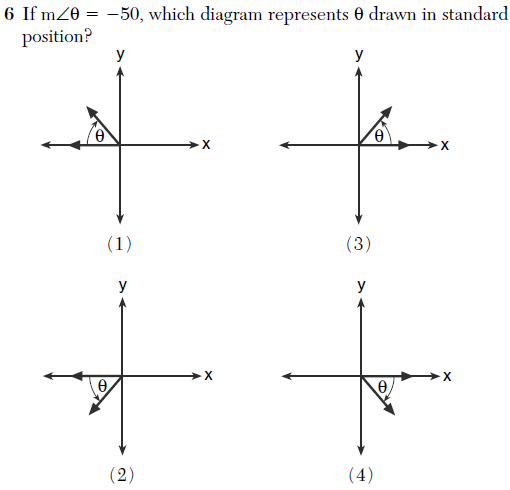Regents Recap — June 2012: Erroneous Questions
Here is another installment from my review of the June 2012 New York State Math Regents exams.
Mathematically erroneous questions consistently appear on these exams. Here are two recent examples, both from the Algebra 2 / Trigonometry exam.
According to the scoring key, the correct answer is (4). This would be the correct answer if the angle were given as -50 degrees. Notice, however, that no degree symbol is present. This means the angle is actually -50 radians. In degrees, -50 radians is equivalent to roughly -2864.8 degrees, which itself is equivalent to roughly 15 degrees. Thus, the actual correct answer is (3).
The above problem could be considered a typo (although no correction was ever issued), but the most erroneous Regents questions demonstrate a real lack of mathematical understanding on the part of the exam creators. Consider the following question on complex numbers.
None of these answers are correct.
The exam writers believe that (3) is the correct answer. Given a complex number a + bi, the conjugate is indeed a – bi, provided that a and b are real numbers. But x is a variable, and there is no reason to assume that x has to be a real number. If x = i, for example, (3) is not the complex conjugate of -5x + 4i. In this case, the conjugate of the original expression is i, while (3) evaluates to – 9i.
As emphasis on standardized exam performance continues to grow, a few points here or there can make a big difference in the lives of students, teachers, and schools. The consistent appearance of erroneous mathematics on these exams calls into question their validity as a measurement of “student achievement”.


7 Comments
Sam Shah · August 8, 2012 at 11:37 pm
Those are pretty egregious. How is this a statewide test and this keeps happening year after year? Give it to 20 math teachers and have them take it and give you feedback. Incorporate feedback. Done.
I am probably missing something here as to why making this test error- and ambiguity-free is so hard. For the life of me, though, I can’t figure out what!
MrHonner · August 9, 2012 at 8:19 am
I can’t figure it out, either. A typo here or there is one thing, but the complex conjugate question (or this trapezoid question, or this inverse function question) demonstrate significant shortcomings in mathematical understanding on the part of the exam writers and editors.
More people should be embarrassed, and outraged, by it.
Ravi · August 24, 2012 at 2:36 pm
I trained as an engineer and one of my colleagues always said you should never blame the person doing the calculations on a project if they turn out to be wrong. You should always blame the person who checked the calculations.
The assumption there is that someone actually checks them. Likewise Sam is spot on – this could quite easily be resolved by getting 20 random maths teachers to do the paper and provide feedback. Mistakes happen yes – but there is no excuse for not having a system in place to catch them.
One of the things I love about maths is the rigour and discipline – these sorts of errors in these tests undermine the whole discipline of maths.
MrHonner · August 25, 2012 at 8:11 am
There is is a system in place; it’s just not transparent, and there doesn’t appear to be any accountability for these errors.
These serious mistakes happen year after year, and at most an official will respond that “typos” occasionally occur. These aren’t incidental errors; these errors indicate a serious deficiency in understanding both mathematics and assessment.
The larger point is that these exams are now used to evaluate teachers and schools as well as students. If the tests themselves aren’t good, how can they be effective evaluations?
bombastic · August 11, 2012 at 10:34 pm
#30 is also incorrect. A little nit-picky, but cos(x)(sec(x) – cos(x)) is not the same as sin^2(x).
MrHonner · August 11, 2012 at 10:41 pm
Yes. A common error for these exam writers is identifying two functions (or expressions) as equivalent even though they have different domains. There were several examples in 2011 (like this: https://mrhonner.com/2011/08/11/are-these-tests-any-good-part-1/); it’s a regular occurrence.
Some people may think it’s nit-picky, but I think failure to understand domain creates lots of problems for students all over mathematics.
steven · April 2, 2019 at 7:30 pm
I don’t find the conjugate question to be misworded. -5x + 4i is introduced as “the complex expression”, the same way I may introduce someone like “Physicist Dr. Doe”. Just as there is no doubt that Doe is a physicist, -5x+4i must be a complex expression, and in turn x must be real.
However, I concede that argument if the term “complex expression” does not indicate an expression with one real part and one imaginary part. Perhaps an expression with just an imaginary part is still called complex?